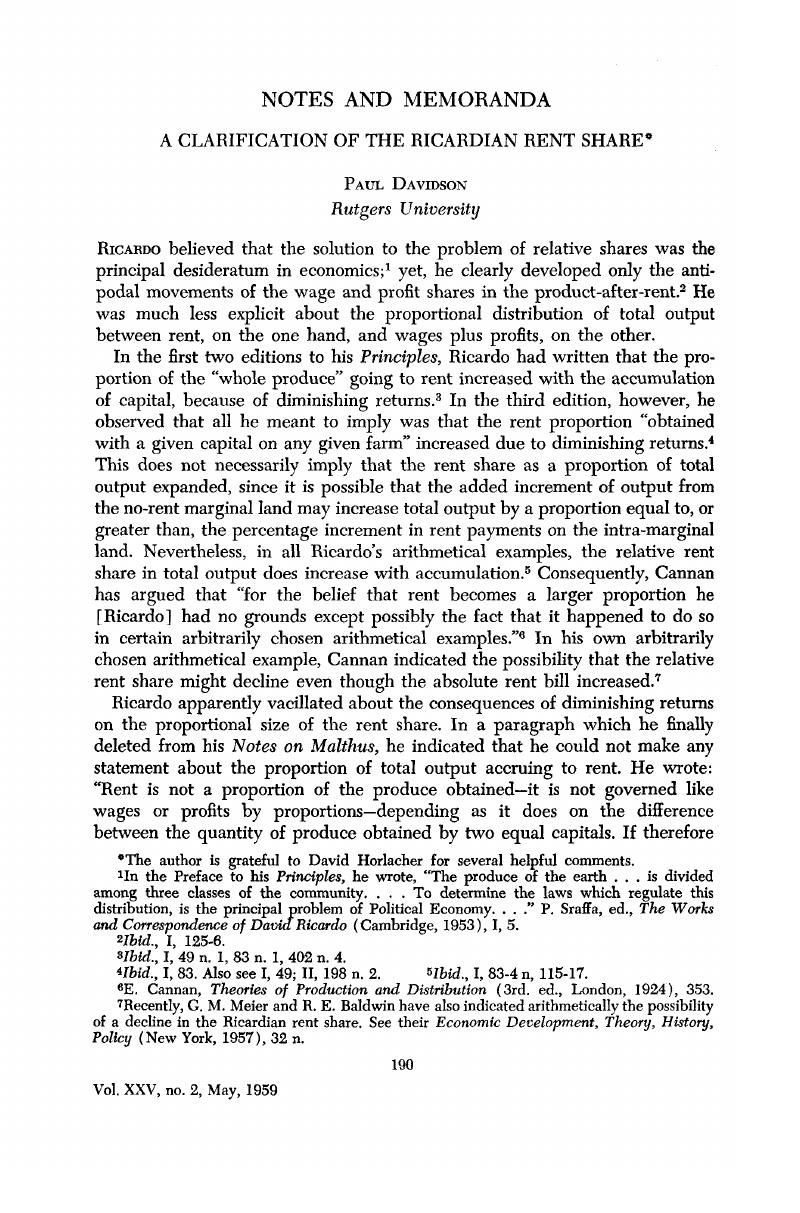Article contents
A Clarification of the Ricardian Rent Share*
Published online by Cambridge University Press: 07 November 2014
Abstract

- Type
- Notes and Memoranda
- Information
- Canadian Journal of Economics and Political Science/Revue canadienne de economiques et science politique , Volume 25 , Issue 2 , May 1959 , pp. 190 - 195
- Copyright
- Copyright © Canadian Political Science Association 1959
Footnotes
The author is grateful to David Horlacher for several helpful comments.
References
1 In the Preface to his Principles, he wrote, “The produce of the earth … is divided among three classes of the community. … To determine the laws which regulate this distribution, is the principal problem of Political Economy. …” Sraffa, P., ed., The Works and Correspondence of David Ricardo (Cambridge, 1953), I, 5.Google Scholar
2 Ibid., I, 125-6.
3 Ibid., I, 49 n. 1, 83 n. 1, 402 n. 4.
4 Ibid., I, 83. Also see I, 49; II, 198 n. 2.
5 Ibid., I, 83-4 n, 115-17.
6 Cannan, E., Theories of Production and Distribution (3rd. ed., London, 1924), 353.Google Scholar
7 Recently, G. M. Meier and R. E. Baldwin have also indicated arithmetically the possibility of a decline in the Ricardian rent share. See their Economic Development, Theory, History, Policy (New York, 1957), 32 n.Google Scholar
8 Sraffa, , ed., Works and Correspondence, II, 196–7 n. 1.Google Scholar Also see ibid., II, 198-9 n. 2.
9 Sraffa has indicated that in attempting to solve the problem of proportional shares in the total product, Ricardo “was troubled by the fact that the size of this product appears to change when the division changes” (ibid., I, xlviii). In other words, Ricardo was bothered by the problem of measuring a heterogeneous basket of goods–the index-number problem. In estimating the value of commodities by the “labour bestowed on their production,” Ricardo believed that he had a measuring unit (Keynes was to employ it in our own generation) that was independent of changes in distribution. Hence, Ricardo could make unambiguous comparisons of proportional shares in the value of output.
10 Actually these are the marginal and average physical product schedules of a dose of labour and capital, that is, labour and capital are always applied in fixed proportions.
11 Diminishing returns imply only that M is decreasing (A may still be rising if returns at lower levels of employment are increasing). In the Ricardian system, however, the possibility of increasing returns is ignored; only constant or decreasing returns are possible. Hence, when M turns down, A must fall.
12 Even in present-day literature, one often finds the inaccurate statement that diminishing returns must mean an increasing rent share; e.g., Weintraub indicates that the gross capitalist share (which is mathematically equivalent to our Ricardian rent share) increases because of diminishing returns. See Weintraub, S., An Approach to the Theory of Income Distribution (Philadelphia, 1958), 46, 56.Google Scholar Our analysis indicates that diminishing returns are a necessary, but not a sufficient condition for an increasing rent share.
13 It is demonstrated (Appendix: Note 1) that the ratio of marginal to average product will be constant when the proportion of labour to land increases (i.e., with diminishing returns) only if the production function is of the form, Q = aNk . Otherwise, diminishing returns with a continuous, monotonic output function imply a decrease in the M/A-ratio (Appendix: Note 2) and, consequently, a rise in the rent share.
14 The assumption of a continuous, monotonic total product function underlies the usual textbook drawings of M and A (such as Figure 1). Once kinks and/or bends are introduced into the total product curve, it is possible to demonstrate all sorts of unusual distributive results in the regions immediately adjacent to these kinks. Both the Cannan and the Meier-Baldwin arithmetical demonstrations of a decline in the rent share (with rising levels of employment) are based on an implicit assumption of a kink in the total product curve.
15 Robinson, J., The Economics of Imperfect Competition (London, 1954), 36.Google Scholar
16 See Carlson, S., Pure Theory of Production (New York, 1956), 56–8.Google Scholar
- 4
- Cited by


